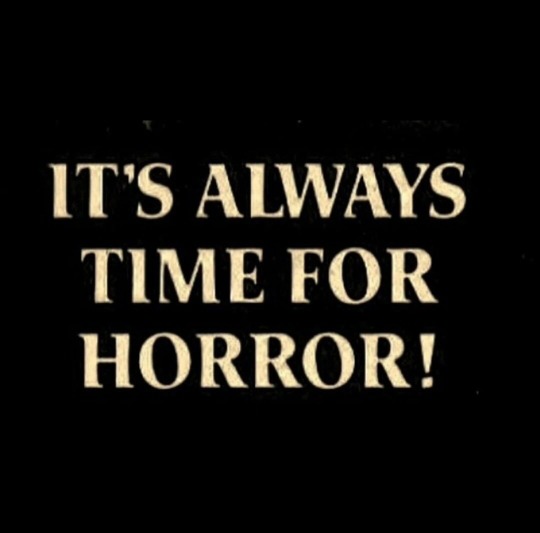#Boris Karloff Grave
Explore tagged Tumblr posts
Text
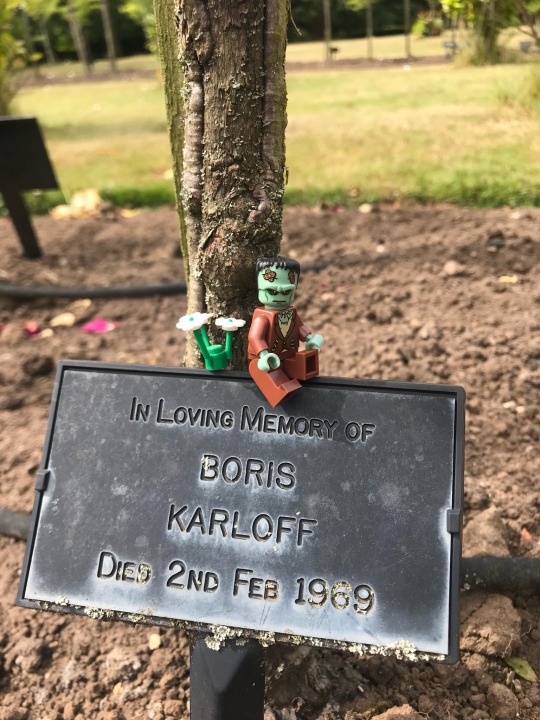
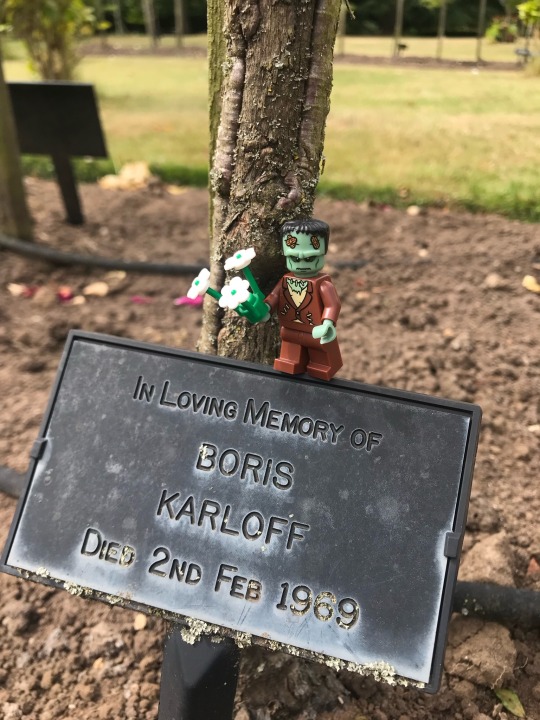

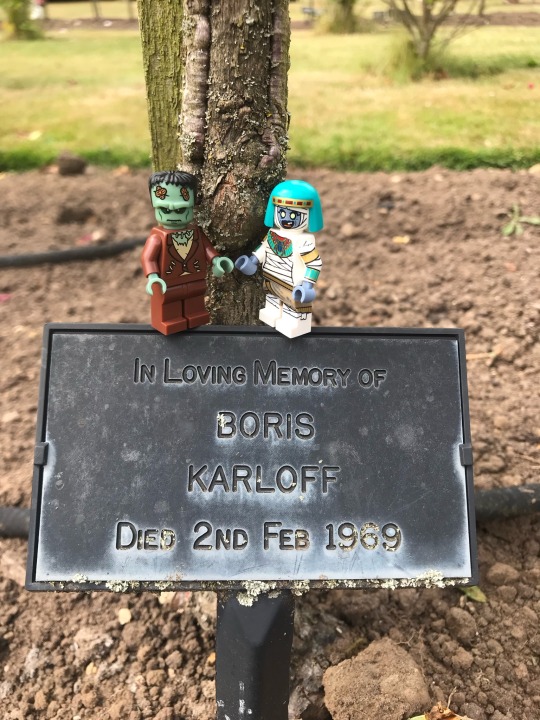
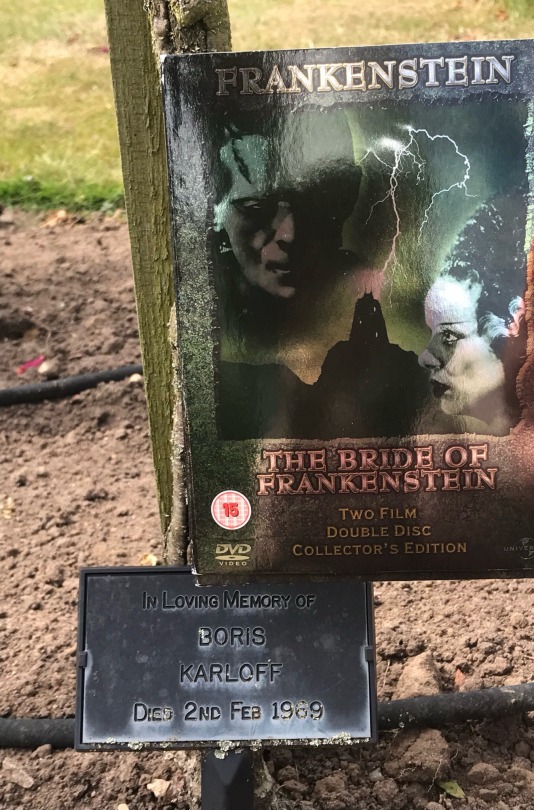
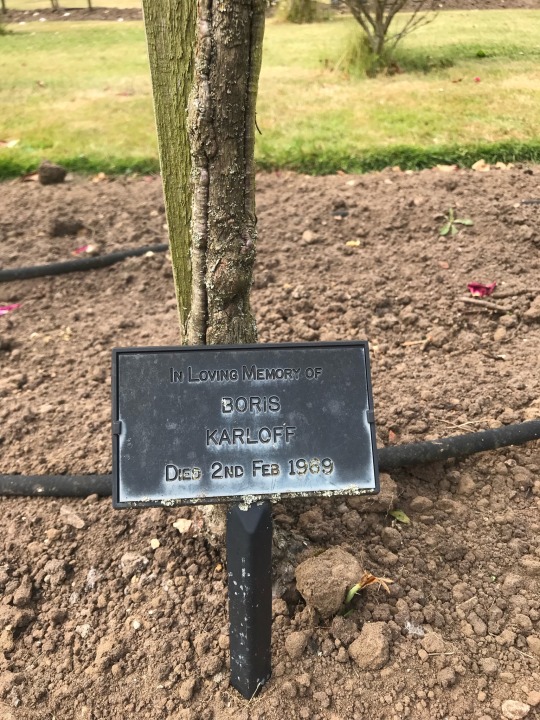

Photos of when I visited Boris Karloff’s memorial plaque in Gildford crematorium, Surrey in July 2022.
It was a very modest memorial, just the same as every other one in the garden of remembrance. I liked that there is a yellow rose growing over his plaque, as Karloff used to grow roses and I like to think of his ghost tending to the bushes there.
Unfortunately I can never confirm whether or not his ashes were actually spread in the crematorium or not. I have heard conflicting stories.
I was a little disappointed that Boris wasn't there to greet me like this...

but maybe he was sick of the living by the time I visited! Our conversation was pleasant, but rather one-sided.
I hope to visit again soon.
#boris karloff#A day late for his death day but I've been busy and exhausted this week#william henry pratt#karloff the uncanny#Gildford Crematorium#Surrey#Godalming Surrey#Crematorium#Boris Karloff Grave#Memorial plaque#Boris Karloff Memorial#Boris Karloff plaque#Thriller#Boris Karloff's Thriller#Boris Karloff Presents#Lego#lego minifigures#Lego Frankenstein's Monster#Lego Mummy#Frankenstein#The Mummy#lego photography#toy photography#My Posts#Frankenstein 1931
6 notes
·
View notes
Text













EYES OF DEATH ON ITALIAN MOVIE POSTERS (1961-1971) - HALLOWEEN SPECIAL (Part 7/10)
If Hands can kill (see Parts 1 and 3) so can eyes especially the ones painted on the beautiful Italian posters for many Crime and Horror movies of the 1960's and 1970's
Enjoy the curated selection above and Click on each image for details to see the movie titles and the names of the various Artists.
ALL OUR PAINTED ITALIAN HORROR and CRIME MOVIE POSTERS ARE HERE
If you like this entry, check the other 19 parts of this week’s Blog as well as our Blog Archives
All our NEW POSTERS are here All our ON SALE posters are here
The posters above courtesy of ILLUSTRACTION GALLERY
#illustraction gallery#illustraction#Halloween#Horror movies#movies#movie poster#vintage#film#italian movie poster#Christopher Lee#Dracula#Dracula has Risen from The Grave#Renato casaro#Renato Ferrini#Edgar Allan Poe#Boris Karloff#Eyes#Death stare
4 notes
·
View notes
Text
Mummy (Pathfinder Second Edition Archetype)

(art by Uriak on DeviantArt)
And it’s time for another archetype from Book of the Dead that lets you play an undead character! This time it’s a pretty interesting one in that we’re looking at: mummies!
Mummies have been in RPGs since the beginning, but their presence as undead creatures is actually relatively recent compared to the age of the culture they come from. That’s right, there are straight up no stories of mummies rising from their grave to torment the living in Ancient Egypt, presumably because a mummy, by necessity, was one that had undergone all the proper rites of death and therefore didn’t have any reason for stories of them rising and complaining about it.
Heck, even The Curse of the Pharaohs, the idea that those that dare disturb the tombs of kings would be cursed with a painful death is fairly recent, with the closest thing we actually have from the various dynasties and periods of the nation being warnings to not disturb or desecrate the tombs and sarcophagi of a pharaoh lest they lose the favor of the gods, but those are more akin to having the awareness to realize that your successor is probably gonna deface any statue of you they can find and strike your name from all records they can get ahold of, because that happened a lot.
The actual undead mummy is actually a creation of foreign writers, going as far back as the 1840s with Gautier’s The Mummy’s Foot, and 60 years later with Bram Stoker’s (yes, that Bram Stoker) The Jewel of the Seven Stars, along with others in that period like Arthur Conan Doyle, and so on.
Curiously, most of these undead mummies were not monsters per se, having no hostile intentions towards mortals, but rather, were often love interests for the protagonists, which smacks of elements of the exotification and sexualization of the East, which is unfortunate. On the other hand, if there’s any online community that can emphasize with the idea of dating an immortal being from a bygone era, it’s tumblr. This focus on desire also explains why even more horror-focused mummy fiction often gives the mummies ways to “rehydrate”, regenerating themselves into a fleshy, lifelike form, if only temporarily and usually at the expense of some poor sap, cursed or otherwise.
Mummies as horror monsters didn’t really start until the 1930’s with Boris Karloff in the Universal Studios The Mummy movie, and even that retains the notion of the mummy regaining a semblance of life, since he only spends one scene of the movie as a shambling corpse and the rest as an offputting older gentleman who politely insists not to be touched.
Beyond that, mummies in fiction have ranged from being similar undead sorcerers to being particularly dusty zombies that may or may not have a would-be necromancer commanding them, and their appearance in tabletop games has similarly varied.
In Pathfinder, the generally accepted paradigm is that mummies range in power from the basic variety, which were typically mere servants or mummified accidentally by extreme outdoor conditions such as bogs, deserts, or extreme altitudes, whereas greater mummies (represented by the Osirian Mummy and Mummified creature templates in First Edition) were a step above, retaining their skills and sense of self. Meanwhile, at the pinnacle were mummy lords, created from the bodies and souls of the most powerful and magically-skilled pharaohs.
However, a detail that was brought into focus with Second Edition was that mummies, no matter what culture they belong to or where they are found, are undead tied to the land, which makes sense due to the way that every mummification process involves at least some level of environmental process, from being soaked in anaerobic bog water/peat to being desiccated by the sun or natron salts, and so on. That connection is what gives many mummies their strange powers over the environments they hail from (like conjuring sandstorms or turning into clouds of sand and the like). Of course, that connection also subtly taints the natural world around them wherever they go, given their status as undead beings.
While it is possible to play a character who underwent the ritual to become a mummy in recent times (either just after death or more horrifyingly while still alive), the nature of this archetype lends itself better to playing a time-displaced undead character who only just woke up from their eternal rest. Whether you’re a millenia-old citizen of a now-defunct desert kingdom or some poor explorer that died in a bog and only clawed their way out a century later when someone accidentally stepped on their head while wading through the muck, there’s a lot of potential there.
So let’s take a look, shall we?
Like all undead archetypes and certain other spellcasting ones, you can technically take this archetype at first level, but must obviously take the dedication as your 2nd level feat. In this case, the dedication provides the basic undead benefits, as well as increased physical durability at the cost of fire vulnerability. Additionally, their unarmed strike becomes stronger as they pull water from their targets on contact. Meanwhile, they also establish a bond with an extreme terrain predominant to the region they were mummified within, which determines the aesthetics of later abilities as well as what terrain certain other abilities function with.
Case in point, most are able to stride through difficult terrain in their bonded environment with ease, as well as see through concealment within it as well, be it the snowstorms of the arctic or mountains, the sand of deserts, or the fogs of the marsh.
Whether it be from their strikes or from another ability, they can use the moisture drawn from other creatures to trigger a transformation, regaining a semblance of life and vitality for a short time.
Many also develop the greater benefits of undeath, as well as resistance to actively harmful aspects of their bonded terrain as well.
Whether they were mummified alive or merely endured the traumas of their soul being bound to their corpse, the process of becoming an undead mummy is filled with anguish, which they can then weaponize in one of their more infamous abilities as an aura of despair. While not yet potent enough to paralyze with fear, it can send foes fleeing.
While this archetype can’t grant true mummy rot, they can inflict a withering necromantic affliction on foes when they get a particularly lucky blow on foes, consuming their vitality and body while it lasts.
Some of these mummies can call upon atmospheric phenomena from their bonded region to summon concealing storms of mist, sand, and the like, making their presence obvious but their exact position impossible to determine, making for a useful defense.
Those of a warrior disposition often learn to channel their lesser curse through weapons rather than their limbs.
While otherwise ordinary cloth, many mummies can infuse some of their malevolence into their wrappings to briefly animate them, following up a strike to entrap foes with them.
Taking their bond with the terrain further, some learn to actually become the terrain, turning into flying clouds of an appropriate substrate such as mist, snow, sand, bog water, and the like.
In a horrific display of their mastery of moisture and life force, powerful mummies can suck both right out of foes in a wide conical area with a horrid inhalation, harming them and healing themselves.
Finally, some refine their despair aura so they can do so more often, and those that are especially affected are outright paralyzed with fear for a few critical moments.
The mummy archetype does a good job of emulating the powers most commonly associated with undead mummies in a balanced way, and can certainly be fun for any sort of character without requiring you to invest super heavily into it. If the game takes place in a lot of set pieces covering their favored terrain, it can be quite powerful if you spec for that, or you can just focus on being an especially tanky undead melee character. Certainly the despair ability is useful for every character, and being able to enshroud oneself or turn into clouds of particulate is useful for close and ranged characters alike. As such, there is no one specific build for this archetype, but you can choose to add it’s benefits to whatever build you’re going for.
Like I said before, it is entirely possible to play a truly ancient undead with this archetype, which opens up some interesting roleplaying opportunities. Obviously culture clash between your original culture and those that exist in the modern era is one, but also consider the knowledge that you bring with you from your old life. After all, undead mummies have included royalty, high priests, mages, and more in fiction, so their perspective can be interesting.
His hairs all fallen out long ago and his husk as dry as an old waybread wafer, Nshantu the Ensnared is the oldest storyteller among the anandi, though that’s hardly an impressive boast since he ventured high into the mountains to become a mummy. Still, the silk-bound arachnid boasts the deepest pool of knowledge in the region, which he will share with those who offer him information in exchange.
In their quest to defeat the risen pharaoh that has kidnapped their patron, whom he believes is a reincarnation of his lover, the party finds a lead in references to one of his old servants, a jaathoom, or djinn genie who still dwells on the material plane.
Ever since the party made it through Blackwater Bog, something has been following them. They sometimes sense something on the edge of the firelight that vanishes when they try to find it, and just yesterday the woman they’ve been escorting found a muddy handprint on her bag. But is this stalker foe, or friend?
15 notes
·
View notes
Text
I posted something similar before but I'll say it again. I think if the Universal Monsters were created today they'd be accused of being woke.
Dracula - Played by an authentic Transylvanian (Bela Lugosi's home town is in Transylvania, which was part of Hungary at the time of Bela Lugosi's Birth). In fact I think he's the only English language Dracula to actually be born in Transylvania AND to have served his nation's army. Dracula's daughter - Canonically NOT straight. Shown to be attracted to men and women. (I know Carmilla was a Lesbian but I'm focussing on the Universal monsters here). Frankenstein - Played by a mixed race actor. (Boris Karloff's mother was Indian) and directed by an openly gay man, James Whale.
The Mummy - Played by a mixed race actor and his character was attracted to a mixed race woman. (Half African). Boris Karloff - who starred in many Universal monster movies, including Frankenstein and The Mummy, was half-Indian.
James Whale - Director of Frankenstein and Bride of Frankenstein. Openly Gay in the 1930s. And Bride of Frankenstein had a lot of gay overtones, particularly with Dr. Pretorius.
Ernest Thesiger - Who played dr. Pretorius in Bride of Frankenstein was openly bisexual in the 1930s. The Wolf-Man - the only American-born of the classic movie monsters. Movie briefly touched on things like classism and racism against the Romani people. Also (ironic since so many people misinterpret it), the Pentacle (a pre-Christian Pagan symbol) was a protection symbol that warned of the werewolf, who the next victim would be, warded against the werewolf, and could (if worn) prevent the werewolf transformation. Though, yes, I know, many medieval Christians used it as a ward against demons.
Oh, no! The classic monsters have gone woke!
Sorry, I never quite got over a few years ago being in a Universal Monsters Facebook group and getting flack for sharing a beautifully rendered piece of art where The Bride of Frankenstein was kissing Lily Munster (a version of Dracula's daughter). One comment even said (unironically) that James Whale would be rolling over in his grave.) Mostly whining of "Wokeness."
9 notes
·
View notes
Text
Le Vourdalak (2023)

Who would win in a fight, elderly Boris Karloff or a puppet? Adrien Beau’s take on the Aleksey Tolstoy novella follows the same path as the central chapter in the Mario Bava anthology film Black Sabbath, recounting the tale of a French nobleman encountering a family preyed upon by the ghastly vourdalak, their own father returned from the grave to drink their blood. But this French adaptation makes an interesting creative choice: this undead iteration of the patriarch Gorcha isn’t a man but rather a puppet. The gaunt, emaciated figure of this elderly man features skeletal fingers and a face ravaged by time, milky eyes and exposed teeth fluctuating between rage and a sort of extreme exhaustion. This gives an even more frightening presence to the creature, its movements stilted and frail, yet threatening nonetheless. Gorcha’s family all react differently to the return of their not-father, from Jegor’s drunken denial to Anja’s grief-stricken apathy to Sdenka and Piotr’s fear and mistrust. The visiting Marquis d’Urfé is out of sorts here, confused by both the landscape and local customs. As with the likes of Bram Stoker’s Dracula, vampirism is presented as a clash between the cultural sensibilities of Western and Eastern Europe. But here, d’Urfé is abroad, a Frenchman visiting Serbia. Wars and ethnic clashes haunt the periphery, from battles between the locals and invading Turks, to the perhaps unwanted presence of the Frenchman in this area. Where Dracula is presented as an Other invading British polite society, here the vourdalak’s proclivity for the blood of loved ones speaks to annihilation from within. This is borne out of trauma and a blind adherence to patriarchal structure even when it’s completely apparent that said patriarch is making terrible decisions.
D’Urfé himself is almost comically inept at dealing with any of the problems he encounters during his trials and tribulations confronting the vourdalak Gorcha. Powdered and polite, he doesn’t know how to navigate his strange surroundings. Attempting to help the young child Vlad who is being lured by the vampiric creature, the Frenchman just ends up getting bitch-slapped by a puppet and knocked unconscious. He manages, by some strange stroke of luck, to kill the vourdalak (only after engaging in some fucking and sucking), but unlike the novella, he succumbs to his wounds. Despite all of the experiences of the court, he’s ill equipped to face such evils.
THE RULES
SIP
Someone says 'Gorcha'.
d'Urfé introduces himself to someone.
Someone makes the Sign of the Cross.
A type of family member is named (ie: father, mother, etc).
BIG DRINK
A dream sequence ends.
Chewing noises are heard.
#le vourdalak#the vourdalak#black sabbath#adrien beau#ariane labed#horror#horror & thriller#vampire movies#french cinema#mario bava
7 notes
·
View notes
Text
The Price May Be Right - Number 13
Welcome to “The Price May Be Right!” I’m counting down My Top 31 Favorite Vincent Price Performances & Appearances! The countdown will cover movies, TV productions, and many more forms of media. Today we focus on Number 13: Dr. Phibes.

So, here’s a random fun fact for you Batman fans out there: apparently, this character was the inspiration for the version of Mr. Freeze that appeared in the seminal animated story, “Heart of Ice.” And, of course, that version of Mr. Freeze would become the inspiration for the character in nearly every other interpretation – both in and out of comics – to date. So, yeah, if you’re a Mr. Freeze fan, you can thank Egghead for it. :P ANYWAY…while Vincent did many, MANY horror movies – both serious and comedic alike – the one thing he never got was the chance to play a horror icon, so to speak. Which is to say, when you look at other great classic horror actors over the years, whatever else they do there’s always one specific character for whom they’ll always be remembered. For Christopher Lee and Bela Lugosi, it was Count Dracula; for Boris Karloff, it was Frankenstein’s Monster; even with more modern actors, like Roger L. Jackson and Robert Englund, they have specific horror roles (The Voice of Ghostface and Freddy Krueger, respectively) for which they will always be most chiefly recognized. Vincent never had that; he never got that recognition of having a specific, classic monster he could be identified with. The closest we ever got was that he was so well-known for his work with the stories of Edgar Allan Poe, but that’s a bit of a different issue. However, in the 1970s, Price DID get a chance to ATTEMPT such a feat, in two films that were part gruesome, gory nightmare fuel and part witty, satirical humor-fests: these were the Dr. Phibes films. The titular character was a deranged musical genius, who wore a mask to hide his hideous skull-like deformities – all elements taken from the timeless tale of “The Phantom of the Opera.” However, the story of the good doctor is rather different: Phibes’ descent into evil began when his beloved wife, Victoria, was stricken with some unholy medical condition. In order to save her life, a risky surgical operation was needed, which was so tricky it required the aid of no less than nine people to even hope for a success. Unfortunately, something went wrong with the operation; as soon as he got the news, Phibes hurried in the direction of the hospital…but was ironically caught in a terrible car crash, and apparently burned to death in the wreck. Husband and wife were then interred together. The rumors of Dr. Phibes’ death, however, were greatly exaggerated. Phibes miraculously survived the crash, and later rose from the grave hideously disfigured by the accident. He brought his wife with him, and kept her body imprisoned in a sarcophagus filled with honey and special fluids, so that her beauty would forever remain intact. In the first film, “The Abominable Dr. Phibes,” the mad maestro goes on a killing spree, attempting to get revenge on the nine people he blames for the death of his wife and the ruination of his existence. In the second film, “Dr. Phibes Rises Again,” the musical maniac returns, now seeking to resurrect his beloved bride. The Phibes films were a bizarre sort of pair. In a way, I sort of see these as the precursor to both the Scream films and the SAW movies. Like the former films, the movies combine elements of parodical dark comedy with real chills and gory, brutal death scenes. Phibes, himself, is treated as a serious and tragic character, and the fear factor is upped by his appearance. The mask he wears to hide his deformities is basically just Vincent’s face with some uncanny valley makeup added to enhance the effect, giving Price a particularly ghoulish appearance. This combined with the special voice box Phibes uses to speak after his accident – which causes Price to speak in a robotic, mechanical, droning sort of way that is both odd and genuinely unsettling – makes the character truly chilling. At the same time, however, he’s a sympathetic villain, as everything he does is in the name of his precious Victoria, and while one recognizes he is the bad guy of the story, it’s hard not to feel sorry for him and understand his motivations. The methods through which he offs his victims are pretty messed up even by today’s standards, too. In all, I would say most of the scares from the film come from Phibes himself. The humor generally is the result of the other characters around him, as well as some the intentionally contrived elements of the plot that are meant to satirize various horror movie tropes. I’m a little surprised there weren’t more films in the Phibes franchise; if there had been, maybe Vincent could have had that one iconic horror character to be recognized by…but, on the other hand, one of the things that made Vincent so fascinating was that he wasn’t someone who could fit into a singular mold, so to speak, and instead had MANY roles for which any given person could recognize him for most keenly. Dr. Phibes was ultimately just one of those parts, but it’s a part well worth remembering. Tomorrow, the countdown continues with Number 12!
#list#countdown#best#favorites#top 31 vincent price performances#the price may be right#vincent price#actors#acting#horror#comedy#dark comedy#dr. phibes#the abominable dr. phibes#dr. phibes rises again#number 13#movies#film
11 notes
·
View notes
Text
Based on the post above:
Henry stops washing the dishes for a moment. His hands actually pause mid-scrub and he stares down at the soapy water with unfocused eyes. It’s been a year, is all he can think, and he feels it more than anything. It’s a stone in his heart and a pit in his stomach and a shadow over the sun. A year ago, his life became heavier, hollower, and darker, and he hasn’t been the same since.
A soft sound from the living room draws Henry out of his head. He cautiously places the plate back in the water and listens hard for if the sound comes again. There it is: a sigh, the rustle of a page. His heart speeds up and he has to swallow back sudden fear. But he makes himself leave the kitchen and walk out to the dining room.
Standing in the arch between dining and living rooms, Henry sees a head of dirty blond hair just over the top of the recliner turned away from him. It’s turned mostly silver-white now, but there are traces of the color it once was threaded throughout. A sigh, a rustle. Is she breathing? Henry isn’t sure she still needs to breathe. He wonders if, like her hair, the person inside the body has changed. If there are any traces of Nora left, like the streaks of blond still in her hair. Or if she’s completely gone, obliterated by the grave.
And if so, what has Henry brought back.
“I can hear you overthinking,” Nora says, without turning her chair around to face him. Can she? She was always an empath, but... “Okay, stop that.” Now she does turn around, slowly, to glare at him. It’s a familiar motion that makes him feel a little better, the way her feet tip-tap-tip on the floor to spin her around bit by bit. It’s something the old Nora would do, before she died, before he desecrated his wife’s grave, god forgive him, how can she...
Nora stands up. She looks good for a dead woman. There are large, crude stitches running up and over her shoulder, and a length of flexible plastic piping running from her chest to the back of her neck, but those are the most obvious signs. Her skin is pale and a little mouldering, her eyes are filmy, and behind the clouds they blaze yellow instead of their former blue. But they focus on him and make Henry feel as if he’s the only one she sees, just as they did when she was alive.
Nora sighs. “This is going to be a whole thing, isn’t it,” she states, not really asking.
“Wha -what?” Henry says. He crosses his arms over his chest. He normally lets the girls run free after a long day, but he’s still got his binder on right now. He doesn’t want Nora to harbor any illusions about her husband - if that’s what he is - technically widower - doesn’t want to lie to her...
“You, me, the ‘What hath science wrought?!’“ Nora throws her hands up as she declaims this in a melodramatic tone straight out of a Boris Karloff movie.
Theater kid even beyond the grave. Henry actually laughs a little, which makes Nora smile.
“Go on, say it,” Nora insists. “Do the whole monologue, it’ll make you feel better hun.”
Hun. Henry’s actually tearing up. “Wh-what ha-ath sciene wr- wrought?” he says shakily. He smiles through his tears. “M-my god, what have I-I done? I’ve...” he trails off, overcome.
“What have you done, pulling me back from the tender embrace of death, snatching me away from hell itself? I am not natural, not human, and therefore I must... destroy!” Nora has crept closer, looming ominously over him, and with that last word she pounces. She seizes Henry by the arms, pulls him close, and kisses him gently.
It’s their first kiss since Henry brought her back to life. It’s not perfect. Nora smells kind of bad, like mildew and rot. Hopefully a few weeks back among the living will clear most of that up. If not... well, Henry was never a fan of Nora’s cigarettes either, but eventually he associated the smell with her and came to accept it, if not love it.
Nora’s always been a little bitey in their kisses. Colleagues think Henry chews his lips out of nerves, but the truth is it’s always been Nora. She sucks his lower lip into her mouth and nibbles on it. Henry can’t help a moan, and he can feel her grin. God, he’s getting turned on by his dead wife, he must be sick in the head or something.
A bop on the head, heavy enough to jar him out of his spiral. “None of that,” Nora murmurs, still so close. Her eyes are closed as she leans into him and Henry automatically wraps his arms around her. She fits there the same as she always has, head on his shoulder, sinking into him. Where they both belong.
“So, am I your wife still?” Nora asks, a little bit teasing, but he can hear the undercurrent of worry in her tone. He kisses her again.
“Yes,” he says. It’s the truth. It’s the only one he knows. But not the only one he needs. “Am - am I... I’ve changed too, I mean.”
Nora is silent for several minutes. Then: “You’re still mine,” she says in a growl. “We can figure the rest out. But... I would like to hear - if you’ll tell me - about while I was... away?”
Henry nods and Nora relaxes. They settle on the couch together, and Henry gathers his thoughts, trying to figure out how to explain what led to his decision not to let go, becoming a mad scientist, and resurrecting his wife.
the "came back wrong" trope except like... they didnt. like this mad scientists wife died, and so he studied necromancy, brought her back, and she came back and it all worked. like she came back exactly the same as she was before with literally no difference. but the scientist guy is like "oh no... what have i done.... shes Different now!!!! she came back Wrong!!!!" and shes just like. chilling. reading a book. cooking dinner. shes just so so normal but in the guys mind hes like "oh shes soooo weird" but shes just normal
281K notes
·
View notes
Text
Fabiano Negri: Muito peso e histórias aterrorizantes em novo álbum

Fabiano Negri: Muito peso e histórias aterrorizantes em novo álbum Fabiano Negri: Muito peso e histórias aterrorizantes em novo álbum, "Mysteries the Night Hides", oficialmente lançado em 1º de dezembro nas principais plataformas digitais de áudio. Seguindo a linha independente de distribuição, Fabiano Negri recebe pedidos diretamente para a aquisição de todo o trabalho artístico, incluindo arquivos digitais, letras, fotos, ficha técnica e artes exclusivas. Fabiano Negro no Instagram @fabianonegrisolo Ouça "Mysteries the Night Hides" em https://onerpm.link/172765273308 São Paulo, 6 de dezembro de 2023 - Alguém menos familiarizado pode se perguntar qual é a relação entre o heavy metal e o horror. A resposta é simples: tudo! Basta lembrar que o Black Sabbath, a banda que deu origem ao estilo, tirou seu nome de um filme homônimo estrelado por Boris Karloff, um ator britânico considerado um dos pioneiros do gênero. Portanto, não é surpreendente que o vocalista, multi-instrumentista, compositor e produtor Fabiano Negri (Rei Lagarto, Dusty Old Fingers) esteja explorando esses territórios em seu mais recente álbum, "Mysteries the Night Hides". Na verdade, sua incursão no heavy metal não é uma completa novidade, já que seu trabalho anterior, o conceitual "ZebathY" (2022), foi completamente influenciado por Black Sabbath e Judas Priest, conforme afirmou Fabiano. "Acredito que tudo reflete o momento e o que tenho ouvido recentemente. Nos últimos anos, tenho voltado a ouvir mais heavy metal e hard rock. Assim, ao compor, é natural tender mais para esse lado mais pesado da música", explicou ele. Entretanto, enquanto o álbum anterior contava a história de uma mulher lutando contra preconceitos, baseando-se na crueza da guitarra pesada e da cozinha direta, "Mysteries the Night Hides" apresenta uma abordagem muito mais elaborada. Possui linhas melódicas acessíveis, mas complexas, destacando significativamente o teclado. Fabiano destaca que "neste disco, as músicas incorporam outros elementos como piano, cordas e órgão, além de serem mais longas e progressivas". Na verdade, com exceção de "The Raven's Feast", lançada em videoclipe e cujo tema fala de uma alma amargurada, condenada a assistir a cena da sua triste morte eternamente, todas as outras faixas ultrapassam os 8 minutos de duração, proporcionando a Fabiano a oportunidade de continuar demonstrando toda sua versatilidade em todos os instrumentos. Mais uma vez, ele foi responsável pelos vocais, guitarra, teclado, baixo e bateria, além da produção e mixagem de "Mysteries the Night Hides" (a masterização foi realizada por Ric Parma). No entanto, isso não significa que a intensidade tenha sido reduzida ou deixada de lado. Os vocais agressivos, a ênfase nos tons graves da cozinha e a guitarra pesada continuam a ser a essência do repertório. Os três singles lançados previamente, "Vampires", "A Necessary Evil" e "Terrifying Lullaby" alcançaram marcas incríveis de audições no Spotify, mostrando que Fabiano alcançou um n��vel de qualidade digna de grandes baluartes do Heavy Metal mundial. Outra característica do disco é que cada um dos cinco temas conta uma história de terror. Fabiano compara: "É como se fosse um 'Tales from the Crypt'", referindo-se ao famoso seriado americano de terror que fez grande sucesso nos anos 90. Ele esclarece: "Sempre gostei desse tema. Sou fã de filmes e literatura de terror e horror. Então, por que não criar minhas próprias histórias?" Essas histórias variam desde o homem que passa seus dias buscando evidências da existência de vida após a morte até o nascimento de um filho do mal destinado a recolher aqueles que propagam mentiras nas redes sociais, abrangendo até o homem condenado a testemunhar seu corpo sendo eternamente devorado por corvos, entre outros temas cuidadosamente elaborados para causar arrepios. "Mysteries the Night Hides", oficialmente lançado em 1º de dezembro em todas as plataformas digitais (também disponível para venda digital com arquivos de altíssima qualidade, letras, fotos, ficha técnica e release em artes exclusivas diretamente com o músico), é um álbum variado, acessível e assustador com o puro creme de la creme do Heavy Metal clássico, ideal para ser ouvido alto e, talvez, durante a noite. Afinal, não é lá que os mistérios se escondem? Assessoria de imprensa JZ Press Read the full article
0 notes
Text
THE SORCERERS (1967) Reviews of Boris Karloff flick - free to watch online
The Sorcerers is a 1967 British science fiction horror film directed by Michael Reeves (She Beast, Witchfinder General), starring Boris Karloff, Catherine Lacey (The Shadow of the Cat), Ian Ogilvy (— And Now the Screaming Starts!; From Beyond the Grave), and Susan George (Die Screaming Marianne, Fright). The original story and screenplay was conceived and written by John Burke. Reeves and his…

View On WordPress
#1967#Boris Karloff#Catherine Lacey#free to watch online#horror#Ian Ogilvy#Michael Reeves#movie film#review#reviews#Susan George#The Sorcerers#Tigon
1 note
·
View note
Text
Shock Theater debuted on October 7, 1957. As the host, Zacherle appeared wearing a long black undertaker’s coat as the character “Roland,” who lived in a crypt with his wife “My Dear” and his lab assistant, Gasport.
The first show aired on Monday, October 7, 1957. The last one was Saturday, September 13, 1958.
Monday, October 7, 1957
(First show)


Frankenstein (1931) Philadelphia TV Debut
A young scientist has fashioned a human body. He is conducting experiments to see if he can give it life.
Starred Boris Karloff and Colin Clive. .
----------------------------
Tuesday, October 8, 1957
Dracula (1931) Philadelphia TV Debut
Count Dracula is a vampire who rises from his grave each night to seek victims from who he can draw the blood he requires.
Starred Bela Lugosi and David Manners.
Saturday, September 13, 1958
Frankenstein Meets the Wolf Man (1943)
(Last show with Roland. The program continued but without a host. It moved to 1 am a month later and was cancelled within a year.)
The purchase of WCAU by CBS in 1958 prompted Zacherle to leave Philadelphia for WABC-TV in New York, where the station added a "y" to the end of his name in the credits.
There ,as Zacherley , He hosted a New York show which morphed into Chiller Theatre . Zacherley left the show in 1965 , but never left our hearts...
Which we keep in the box .
0 notes
Video
youtube
The Grave of Boris Karloff...and More!!! (Frankenstein, The Mummy) 4K
1 note
·
View note
Photo









Horror-comedy masterpiece, The Comedy Of Terrors – featuring Vincent Price, Boris Karloff, Peter Lorre and Basil Rathbone at their spooky/wacky best, in a tale about an undertaker who resorts to murder when business gets slow – crept into theaters on January 22, 1964.
#daves faves#cult film#pop culture#midnight movies#classic horror#comedy horror#american international pictures#gothic horror#richard matheson#jacques tourneur#vincent price#peter lorre#boris karloff#basil rathbone#joe e. brown#joyce jameson#recommended#movie poster#campy horror#grave robbery#murder
61 notes
·
View notes
Video
tumblr
Top 3 Grave Digging Movies
#body snatchers#grave digger#grave robber#i sell the dead#the doctorand the devils#the bodysnatcher#boris karloff#bela lugosi#timothy dalton#ron perlman#robert wise#robert louis stevenson#Horror Movies#horror#movie review#movies
28 notes
·
View notes
Audio

This week on Content Abnormal we present three more Tales Of The Frightened told by Boris Karloff. Also presented is “The Story Of Wood”, told too by Karloff, and the song “Monster Friends” by our own Keith “Creepy Clyde” Brown!
#tales of the frightened#boris karloff#the story of wood#otr#horror host#monster friends#creepy clyde#keith perry brown#frankentyner#area mca51#reese's franken cups#voice from the grave#don't lose your head#just inside the cemetary#karloff the uncanny#frankenstein's monster#hell michigan#scream's ice cream parlor#woodward avenue#Jesse
2 notes
·
View notes
Text

the Monster is made of corpse parts. Victor is the narrator and ashamed of what he has done for numerous reasons, so he avoids outright saying, "i made the Monster out of corpse parts," but it's obviously what he did.
grief stricken by his mother's death, he develops an obsession with reanimating the dead. he discusses how a dissection room and slaughterhouse are involved with his experiment, admits he "dabbled among the unhallowed damps of the grave [and] tortured the living animal to animate the lifeless clay," refers to material clinically as "nonliving matter," and admits to purposefully selecting beautiful features for the Monster, which he builds over time.
in one passage, he describes some of his methodology:
I collected bones from charnel-houses and disturbed, with profane fingers, the secrets of the human frame. In a solitary chamber, or rather cell, at the top of the house, and separate from all the other apartments by a gallery and staircase, I kept my workshop of filthy creation ... The dissecting room and the slaughterhouse furnished many of my materials.
the Monster's description then confirms what he's made of:
His limbs were in proportion, and I had selected his features as beautiful. Beautiful! Great God! His yellow skin scarcely covered the work of muscles and arteries beneath; his hair was of a lustrous black, and flowing; his teeth of a pearly whiteness; but these luxuriances only formed a more horrid contrast with his watery eyes, that seemed almost of the same colour as the dun-white sockets in which they were set, his shrivelled complexion and straight black lips.

i'm not even sure what this part means. i am very aware of many actors known for playing monsters, as evidenced by the fact i am discussing one--Boris Karloff-- in this post, but Doug Jones was specifically who was being considered for that project.
Freaky Facts: Frankenstein (1931)












(My Review) (My Screenshots)
83 notes
·
View notes
